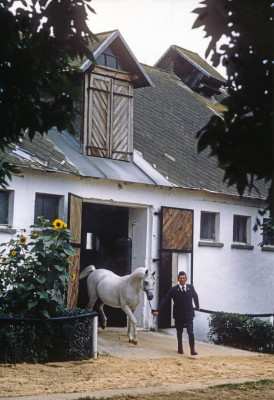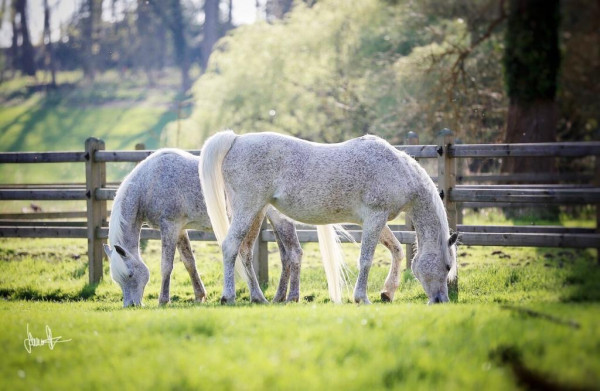Wisdom from the Breeding Shed with Sherry Conrads
Sherry Conrads is still over the moon after her home-bred filly, Al Noor Miralina (Om El Maximus x Balajka V), was named Arabian Breeders World Cup Silver Champion Yearling Filly, Gold Champion Emirates Yearling Filly, and Best Head of the show.
But for Sherry, it’s all about the breeding program. “I was hesitant to bring Miralina to Scottsdale – she was so young, but part of me wanted to see Om El Maximus get his due. I told handler Andy Sellman, ‘here’s the deal: I know what we’ve got, Janina knows what we’ve got, you know what we’ve got, the pressure’s off.’ At my age, my goal is to preserve the best of the Arabian horse. If that means that a better horse wins, that’s good news! When Miralina was second to Orrion’s beautiful filly I was thrilled to death."
Sherry recalls being a horse crazy girl. “My best friend, Leslie, had purebred flea-bitten grey mare named Blue. We were like two peas in a pod. Nobody rode my Half-Arabian, Dan, except me and Leslie, and nobody rode Blue except Leslie and me.
 Al Noor Miralina (Om El Maximus x Balajka V), bred and owned by Sherry Conrads.
Al Noor Miralina (Om El Maximus x Balajka V), bred and owned by Sherry Conrads.
“Then we moved to Texas, not far from Gleannloch Farms, and my dad bought two Quarter Horse mares and bred them to Gleannloch’s stallion Surf (Sureyn x Jubilema). That was my first introduction to a purebred Arab.
“Decades passed, I married and we raised a family. So I had a life without horses…but for my 60th birthday I went to visit Sheila Varian. Of course I knew all about Bay Abi and her whole program. She looked at me and said, ‘You need a HORSE!’ We walked into the barn and there was Breathless V (Jullyen El Jamaal x Bint Balalinka). Talk about falling in love! So Bob bought her for my 60th birthday.”
After a lifetime of waiting for horses, Sherry was kind enough to share her advice from the breeding shed. She might want to add one more: It’s never too late to begin again.
1. Build your knowledge and confidence before you invest in breeding stock. There is a plethora of literature, photos and videos that you can peruse to learn the language of equine anatomy and physiology.
2. What type of horse do you want to breed? There is a wide range of types within all breeds, including the Arabian breed. Do you want to breed a halter showhorse or do you want to breed a park performance horse champion? Those are very different types of Arabian horses. Find a type of Arabian horse that makes your heart rate increase. Fall in love.
3. Attend every show possible to learn which anatomical attributes contributeto the usefulness of the type of horse you want to breed. Take photographs of these horses or cut photos out of magazines and off the internet. Then analyze them systematically. Eventually you will train your eye to recognize the conformation standard that you want to breed toward.
4. The best way I’ve found to learn conformation is by attending dedicated conformation clinics. Here you can learn from lectures, video, photographs, skeletons and then apply that knowledge to hands-on judging with Arabian horses.
5. I applaud the breeders who open their farms to clinics, often at their own expense. It’s a lot of work, and I appreciate all of the breeders and clinicians who so unselfishly offer clinics to the public.
6. Find a mentor who is breeding the kind of horse you want to breed. Visit their farms and introduce yourself at horse shows. Remember, you can see much further by standing on the shoulders of giants.
7. Any success that I’ve had as a breeder is directly the result of the mentoring I’ve received from some of the giants of the Arabian breeding community, Sheila Varian, Sigi Siller and Janina Merz.
Ask your mentor to help you purchase foundation stock, either from themselves or others. Paying them a commission and or consulting fee could be the best investment you’ll ever make.
8. Invest for quality not quantity. Buy the best mare you can afford. One good mare is worth far more than several average mares.
9. Don’t be fooled into thinking that you can improve an average mare by simply breeding her to a superior stallion. And don’t think you can increase your odds of producing an excellent foal by breeding several average mares. In my opinion, it doesn’t work that way.
10. What if you can’t afford to purchase a great mare? Perhaps a breeder would be willing to sell you an older mare who could give you one or two foals. Of course you are then responsible for caring for that older mare in her retirement.
11. Rather than purchasing an older mare, perhaps you could be lucky enough to purchase an embryo from a great mare or even lease a great mare. Sometimes established breeders have a surplus of breeding mares, and you may be lucky enough to use one for far less money than owning them outright.
12. Select your breeding stock with your eyes wide open. In particular, know if either the mare or the stallion carries any congenital diseases which, when combined, could result in tragedy. Examples are Severe Combined Immunodeficiency, Cerebellar Abiotrophy, Lavender Foal Syndrome or Occipitoatlantoaxial Malformation. I’m not suggesting that we eliminate all breeding stock that are carriers of these diseases, but rather manage these breedings so that you don’t breed a mare and stallion who are both carriers. Why not simply eliminate these diseases from the gene pool? I used to think that way, but I now realize that some of the greatest horses in the Arabian breed are carriers. Rather than eliminate them, I choose to manage them. If you choose to breed to a carrier, then test the resulting foal, so you will know where you stand. These diseases are not a death sentence, but they do need to be managed. University of California at Davis and other labs can test your foals in a convenient and inexpensive way.
13. Cull mercilessly. Keep only those fillies and colts that will help you reach your breeding goals.
Sheila Varian taught me that breeding a good mare to an equally good stallion will produce quality along a bell curve. If you breed the same cross 10 times, one foal will be of better quality than that of the sire and the dam. One foal will be noticeablylesser quality. The rest will fall along the bell curve. Retain only those foals that fall on the positive side of the bell curve.
14. That said, find good homes for all of the foals you create. Remember that while a colt may not be stallion quality, he may make a lifelong companion riding horse, worth his weight in gold. Or a filly may make a fabulous performance horse. Not all foals are destined to breed on, but they all deserve a good life. If you can’t fulfill the responsibility of finding good homes for all of your foals, then don’t breed them.
15. Keep your breeding options open to as many stallions as possible. I know it’s tempting to own a wonderful Arabian breeding stallion, but for a small breeder like me, it makes more sense to select from individual stallions for each mare. Even the best stallion may not fulfill the needs of all your mares. Treat them as unique individuals with unique breeding needs.
16. Finally, know that breeding Arabian horses is a long-game pursuit. If you are the kind of person who needs instant gratification, then breeding horses might not be for you. If, however, you find it richly rewarding, indeed thrilling, to plan, breed and await a birth, then I can think of no more rewarding pursuit. I’ve never lost the pure joy of seeing the newborn foal. It takes my breath away.

























